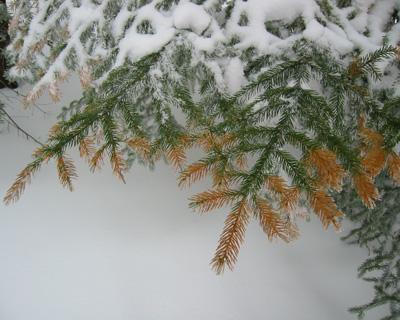Quantifying the Influence of Winter Injury on Carbon Sequestration for Red Spruce Trees within the Northern Forest: Assessing Forest Health to Inform Policy and Economics

Red spruce winter injury, associated with red spruce decline in the Northern Forest, results from needle freezing that can lead to crown thinning and eventual tree mortality. NSRC researchers set out to measure impacts of this injury on long-term carbon storage in red spruce trees. They collected tree stem increment cores from 10-15 dominant red spruce trees in 30 forest plots in Vermont, New Hampshire, and Massachusetts. From the cores, they measured annual tree diameter growth and, in combination with growth equations and USDA Forest Service Forest Inventory and Analysis (FIA) data, estimated impacts on aboveground carbon storage for red spruce across the region.
Needle loss from winter injury reduced red spruce growth for three or more years following the 2003 winter injury event in the Northeast. Although reduction in growth was not extensive for any one tree, cumulative loss for red spruce trees across the region was substantial – about 673,000 metric tons of carbon (roughly equivalent to burning 280 million gallons of gasoline). Importantly however, trees injured in 2003 experienced a surprising growth rebound since 2007. For trees in this study, yearly growth is now at the highest level in the last 100 years, nearly twice the average growth over the last century.
The surprising growth rebound is good news for red spruce, a species known for growth decline and tree mortality associated with acid rain. The new question for researchers and forest managers is WHY this growth surge is occurring. Is it associated with pollution reductions, warmer winter temperatures, or other changes in the Northern Forest?
